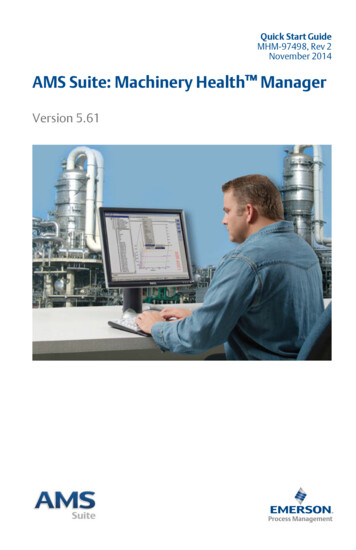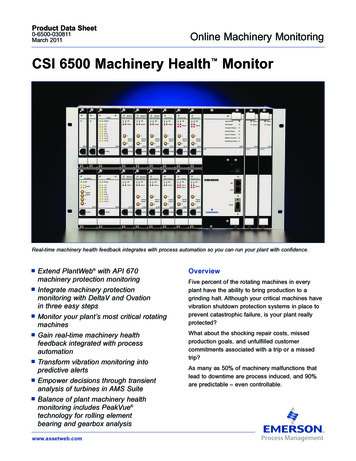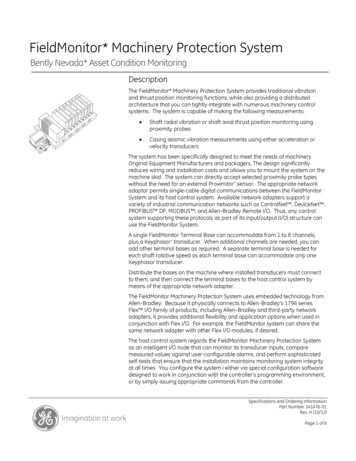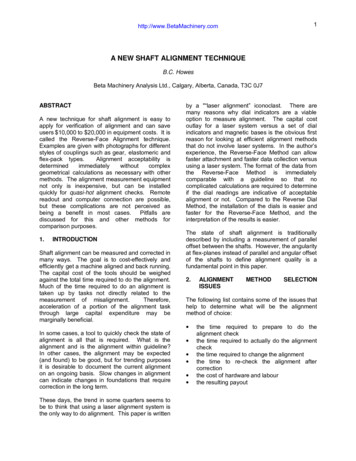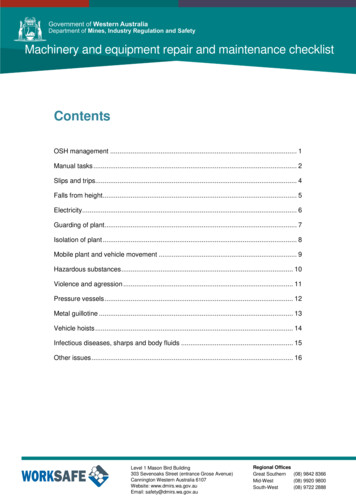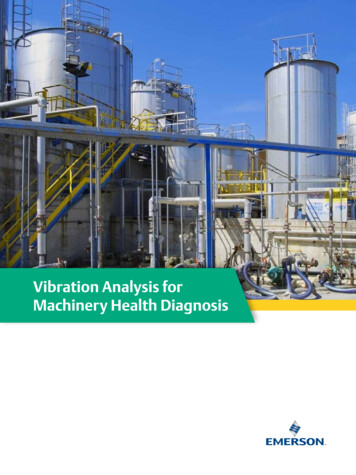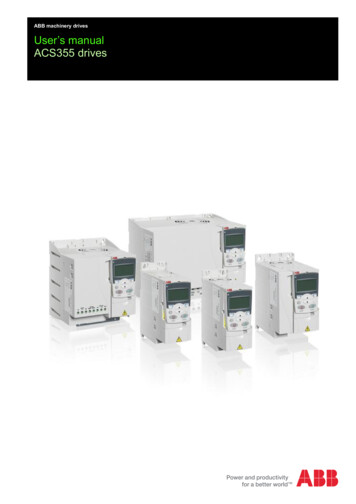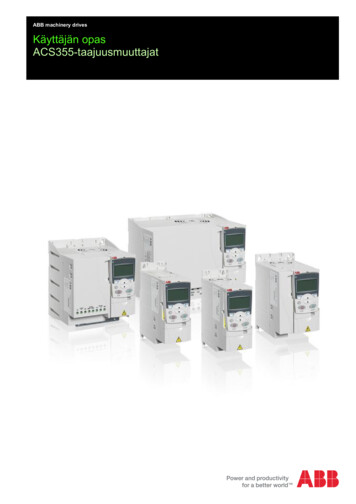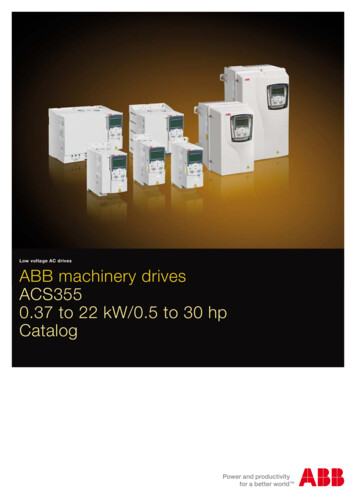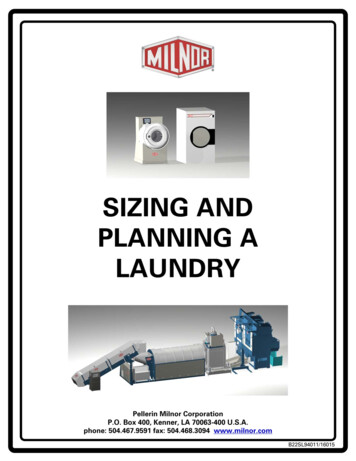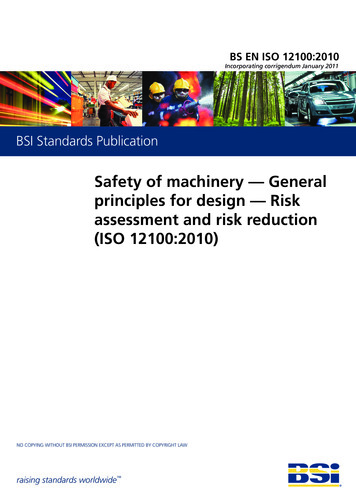
Transcription
BS EN ISO 12100:2010Incorporating corrigendum January 2011BSI Standards PublicationSafety of machinery — Generalprinciples for design — Riskassessment and risk reduction(ISO 12100:2010)NO COPYING WITHOUT BSI PERMISSION EXCEPT AS PERMITTED BY COPYRIGHT LAWraising standards worldwide
BS EN ISO 12100:2010BRITISH STANDARDNational forewordThis British Standard is the UK implementation ofEN ISO 12100:2010. It supersedes BS EN ISO 12100-1:2003 A1:2009,BS EN ISO 12100-2:2003 A1:2009 and BS EN ISO 14121-1:2007which are withdrawn.The UK participation in its preparation was entrusted to TechnicalCommittee MCE/3, Safeguarding of machinery.A list of organizations represented on this committee can beobtained on request to its secretary.This standard was formed by combining the latest versions ofISO 12100-1:2003, ISO 12100-2:2003 and ISO 14121-1:2007 withoutintroducing technical changes. Although efforts were made tomaintain a balance between the emphases of these individualstandards, some compromises have been made. For example,whereas Clause 4 of ISO 12100-1 included requirements andsupplementary information for hazard identification, ISO 12100 hasadopted the approach of ISO 14121-1 by separating therequirements (see Subclause 5.4) from supplementary information(see informative Annex B). This compromise in no way indicates thatthe identification of hazards has been given a reduced prominence,as it remains a vital stage in the process of designing safe machinery.This publication does not purport to include all the necessaryprovisions of a contract. Users are responsible for its correctapplication. BSI 2011ISBN 978 0 580 74262 0ICS 13.110Compliance with a British Standard cannot confer immunity fromlegal obligations.This British Standard was published under the authority of theStandards Policy and Strategy Committee on 31 December 2010.Amendments issued since publicationDateText affected31 January 2011 Correction to pagination
EN ISO 12100EUROPEAN STANDARDNORME EUROPÉENNEEUROPÄISCHE NORMNovember 2010ICS 13.110Supersedes EN ISO 12100-1:2003, EN ISO 121002:2003, EN ISO 14121-1:2007English VersionSafety of machinery - General principles for design - Riskassessment and risk reduction (ISO 12100:2010)Sécurité des machines - Principes généraux de conception- Appréciation du risque et réduction du risque (ISO12100:2010)Sicherheit von Maschinen - AllgemeineGestaltungsleitsätze - Risikobewertung undRisikominderung (ISO 12100:2010)This European Standard was approved by CEN on 9 October 2010.CEN members are bound to comply with the CEN/CENELEC Internal Regulations which stipulate the conditions for giving this EuropeanStandard the status of a national standard without any alteration. Up-to-date lists and bibliographical references concerning such nationalstandards may be obtained on application to the CEN-CENELEC Management Centre or to any CEN member.This European Standard exists in three official versions (English, French, German). A version in any other language made by translationunder the responsibility of a CEN member into its own language and notified to the CEN-CENELEC Management Centre has the samestatus as the official versions.CEN members are the national standards bodies of Austria, Belgium, Bulgaria, Croatia, Cyprus, Czech Republic, Denmark, Estonia,Finland, France, Germany, Greece, Hungary, Iceland, Ireland, Italy, Latvia, Lithuania, Luxembourg, Malta, Netherlands, Norway, Poland,Portugal, Romania, Slovakia, Slovenia, Spain, Sweden, Switzerland and United Kingdom.EUROPEAN COMMITTEE FOR STANDARDIZATIONCOMITÉ EUROPÉEN DE NORMALISATIONEUROPÄISCHES KOMITEE FÜR NORMUNGManagement Centre: Avenue Marnix 17, B-1000 Brussels 2010 CENAll rights of exploitation in any form and by any means reservedworldwide for CEN national Members.Ref. No. EN ISO 12100:2010: E
This page deliberately left blank
BS EN ISO 12100:2010EN ISO 12100:2010 (E)ForewordThis document (EN ISO 12100:2010) has been prepared by Technical Committee ISO/TC 199 "Safety ofmachinery" in collaboration with Technical Committee CEN/TC 114 “Safety of machinery” the secretariat ofwhich is held by DIN.This European Standard shall be given the status of a national standard, either by publication of an identicaltext or by endorsement, at the latest by May 2011, and conflicting national standards shall be withdrawn at thelatest by November 2013.Attention is drawn to the possibility that some of the elements of this document may be the subject of patentrights. CEN [and/or CENELEC] shall not be held responsible for identifying any or all such patent rights.This document supersedes EN ISO 12100-1:2003, EN ISO 12100-2:2003, EN ISO 14121-1:2007.This second edition cancels and replaces ISO 12100-1:2003, ISO 12100-1:2003/Amd. 1: 2009, ISO 121002:2003, ISO 12100-2:2003/Amd. 1: 2009 and ISO 14121-1:2007 of which it constitutes a consolidation withouttechnical changes. Documentation (e.g. risk assessment, type-C standards) based on these replaceddocuments need not be updated or revised.This document has been prepared under a mandate given to CEN by the European Commission and theEuropean Free Trade Association, and supports essential requirements of EU Directive(s).For relationship with EU Directive(s), see informative Annex ZA, which is an integral part of this document.According to the CEN/CENELEC Internal Regulations, the national standards organizations of the followingcountries are bound to implement this European Standard: Austria, Belgium, Bulgaria, Croatia, Cyprus, CzechRepublic, Denmark, Estonia, Finland, France, Germany, Greece, Hungary, Iceland, Ireland, Italy, Latvia,Lithuania, Luxembourg, Malta, Netherlands, Norway, Poland, Portugal, Romania, Slovakia, Slovenia, Spain,Sweden, Switzerland and the United Kingdom.Endorsement noticeThe text of ISO 12100:2010 has been approved by CEN as a EN ISO 12100:2010 without any modification.3
BS EN ISO 12100:2010EN ISO 12100:2010 (E)Annex ZA(informative)Relationship between this European Standard and the EssentialRequirements of EC Directive 2006/42/ECThis European Standard has been prepared under a mandate given to CEN by the European Commission[and the European Free Trade Association] to provide a means of conforming to Essential Requirements ofthe New Approach Directive Machinery, 2006/42/EC.Once this standard is cited in the Official Journal of the European Union under that Directive and has beenimplemented as a national standard in at least one Member State, compliance with the normative clauses ofthis standard confers, within the limits of the scope of this standard, a presumption of conformity with therelevant Essential Requirements of that Directive and associated EFTA regulations.WARNING — Other requirements and other EU Directives may be applicable to the product(s) fallingwithin the scope of this standard.4
BS EN ISO 12100:2010ISO 12100:2010(E)ContentsPageForeword .vIntroduction.vi1Scope .12Normative references.13Terms and definitions .14Strategy for risk assessment and risk .55.5.15.5.25.5.35.65.6.15.6.25.6.3Risk assessment .12General .12Information for risk assessment.12Determination of limits of machinery .13General .13Use limits.13Space limits.14Time limits .14Other limits.14Hazard identification .14Risk estimation .16General .16Elements of risk.17Aspects to be considered during risk estimation.19Risk evaluation .21General .21Adequate risk reduction .21Comparison of 6.2.86.2.96.2.106.2.116.2.126.2.136.2.14Risk reduction.22General .22Inherently safe design measures.23General .23Consideration of geometrical factors and physical aspects .23Taking into account general technical knowledge of machine design .24Choice of appropriate technology .25Applying principle of positive mechanical action.25Provisions for stability.25Provisions for maintainability .26Observing ergonomic principles .26Electrical hazards .27Pneumatic and hydraulic hazards .27Applying inherently safe design measures to control systems .28Minimizing probability of failure of safety functions .33Limiting exposure to hazards through reliability of equipment .33Limiting exposure to hazards through mechanization or automation of loading (feeding)/unloading (removal) operations.346.2.15 Limiting exposure to hazards through location of setting and maintenance points outsidedanger zones .346.3Safeguarding and complementary protective measures .346.3.1 General .346.3.2 Selection and implementation of guards and protective devices.356.3.3 Requirements for design of guards and protective devices.406.3.4 Safeguarding to reduce emissions.43 ISO 2010 – All rights reservediii
BS EN ISO 12100:2010ISO 12100:2010(E)6.3.56.46.4.1
ISO 12100-1:2003, ISO 12100-2:2003 and ISO 14121-1:2007 without introducing technical changes. Although efforts were made to maintain a balance between the emphases of these individual standards, some compromises have been made. For example, whereas Clause 4 of ISO 12100-1 included requirements and supplementary information for hazard identification, ISO 12100 has adopted the
